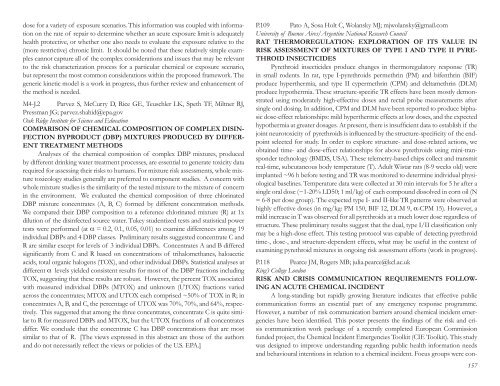Final Program - Society for Risk Analysis
Final Program - Society for Risk Analysis
Final Program - Society for Risk Analysis
Create successful ePaper yourself
Turn your PDF publications into a flip-book with our unique Google optimized e-Paper software.
dose <strong>for</strong> a variety of exposure scenarios. This in<strong>for</strong>mation was coupled with in<strong>for</strong>mationon the rate of repair to determine whether an acute exposure limit is adequatelyhealth protective, or whether one also needs to evaluate the exposure relative to the(more restrictive) chronic limit. It should be noted that these relatively simple examplescannot capture all of the complex considerations and issues that may be relevantto the risk characterization process <strong>for</strong> a particular chemical or exposure scenario,but represent the most common considerations within the proposed framework. Thegeneric kinetic model is a work in progress, thus further review and enhancement ofthe method is needed.M4-J.2 Parvez S, McCurry D, Rice GE, Teuschler LK, Speth TF, Miltner RJ,Pressman JG; parvez.shahid@epa.govOak Ridge Institute <strong>for</strong> Science and EducationCOMPARISON OF CHEMICAL COMPOSITION OF COMPLEX DISIN-FECTION BYPRODUCT (DBP) MIXTURES PRODUCED BY DIFFER-ENT TREATMENT METHODSAnalyses of the chemical composition of complex DBP mixtures, producedby different drinking water treatment processes, are essential to generate toxicity datarequired <strong>for</strong> assessing their risks to humans. For mixture risk assessments, whole mixturetoxicology studies generally are preferred to component studies. A concern withwhole mixture studies is the similarity of the tested mixture to the mixture of concernin the environment. We evaluated the chemical composition of three chlorinatedDBP mixture concentrates (A, B, C) <strong>for</strong>med by different concentration methods.We compared their DBP composition to a reference chlorinated mixture (R) at 1xdilution of the disinfected source water. Tukey studentized tests and statistical powertests were per<strong>for</strong>med (at a = 0.2, 0.1, 0.05, 0.01) to examine differences among 19individual DBPs and 4 DBP classes. Preliminary results suggested concentrate C andR are similar except <strong>for</strong> levels of 3 individual DBPs. Concentrates A and B differedsignificantly from C and R based on concentrations of trihalomethanes, haloaceticacids, total organic halogens (TOX), and other individual DBPs. Statistical analyses atdifferent a levels yielded consistent results <strong>for</strong> most of the DBP fractions includingTOX, suggesting that these results are robust. However, the percent TOX associatedwith measured individual DBPs (MTOX) and unknown (UTOX) fractions variedacross the concentrates; MTOX and UTOX each comprised ~50% of TOX in R; inconcentrates A, B, and C, the percentage of UTOX was 70%, 70%, and 64%, respectively.This suggested that among the three concentrates, concentrate C is quite similarto R <strong>for</strong> measured DBPs and MTOX, but the UTOX fractions of all concentratesdiffer. We conclude that the concentrate C has DBP concentrations that are mostsimilar to that of R. [The views expressed in this abstract are those of the authorsand do not necessarily reflect the views or policies of the U.S. EPA.]P.109 Pato A, Sosa Holt C, Wolansky MJ; mjwolansky@gmail.comUniversity of Buenos Aires/Argentine National Research CouncilRAT THERMOREGULATION: EXPLORATION OF ITS VALUE INRISK ASSESSMENT OF MIXTURES OF TYPE I AND TYPE II PYRE-THROID INSECTICIDESPyrethroid insecticides produce changes in thermoregulatory response (TR)in small rodents. In rat, type I-pyrethroids permethrin (PM) and bifenthrin (BIF)produce hyperthermia, and type II cypermethrin (CPM) and deltamethrin (DLM)produce hypothermia. These structure-specific TR effects have been mostly demonstratedusing moderately high-effective doses and rectal probe measurements aftersingle oral dosing. In addition, CPM and DLM have been reported to produce biphasicdose-effect relationships: mild hyperthermic effects at low doses, and the expectedhypothermia at greater dosages. At present, there is insufficient data to establish if thejoint neurotoxicity of pyrethroids is influenced by the structure-specificity of the endpointselected <strong>for</strong> study. In order to explore structure- and dose-related actions, weobtained time- and dose-effect relationships <strong>for</strong> above pyrethroids using mini-transpondertechnology (BMDS, USA). These telemetry-based chips collect and transmitreal-time, subcutaneous body temperature (T). Adult Wistar rats (8-9 weeks old) wereimplanted ~96 h be<strong>for</strong>e testing and TR was monitored to determine individual physiologicalbaselines. Temperature data were collected at 30 min intervals <strong>for</strong> 5 hr after asingle oral dose (~1-20% LD50; 1 ml/kg) of each compound dissolved in corn oil (N= 6-8 per dose group). The expected type I- and II-like TR patterns were observed athighly effective doses (in mg/kg: PM 150, BIF 12, DLM 9, a-CPM 15). However, amild increase in T was observed <strong>for</strong> all pyrethroids at a much lower dose regardless ofstructure. These preliminary results suggest that the dual, type I/II classification onlymay be a high-dose effect. This testing protocol was capable of detecting pyrethroidtime-, dose-, and structure-dependent effects, what may be useful in the context ofexamining pyrethroid mixtures in ongoing risk assessment ef<strong>for</strong>ts (work in progress).P.118 Pearce JM, Rogers MB; julia.pearce@kcl.ac.ukKing’s College LondonRISK AND CRISIS COMMUNICATION REQUIREMENTS FOLLOW-ING AN ACUTE CHEMICAL INCIDENTA long-standing but rapidly growing literature indicates that effective publiccommunication <strong>for</strong>ms an essential part of any emergency response programme.However, a number of risk communication barriers around chemical incident emergencieshave been identified. This poster presents the findings of the risk and crisiscommunication work package of a recently completed European Commissionfunded project, the Chemical Incident Emergencies Toolkit (CIE Toolkit). This studywas designed to improve understanding regarding public health in<strong>for</strong>mation needsand behavioural intentions in relation to a chemical incident. Focus groups were con-157
















